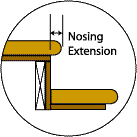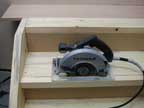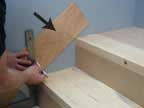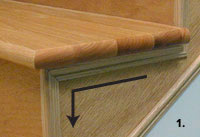How To Install Oak Stair Tread
Installing stair treads is a great DIY project, all you need is a little knowledge!
Learning how to install oak stair treads is not brain surgery, but rather a set of patience steps (no pun intended). It is one of a few jobs that can be done in bits and pieces, without extensive hand skills. To install hardwood stairs, you need patience and the ability to use a tape measure, and the know-how we are offering below. Here’s the basic stages of stair tread installation…
Step #1: Cutting off the existing stair tread nosing
 Typically with a rough set of steps, the stair tread’s nosing extends beyond the back of the step below it. This “nosing” must be cut off as the first step in install recover hardwood stairs.
Typically with a rough set of steps, the stair tread’s nosing extends beyond the back of the step below it. This “nosing” must be cut off as the first step in install recover hardwood stairs.
It is easiest to use a power saw for most of the job and finish it with a hand saw when you get closer to each end…. OR if you are lucky enough to own a Fein multi-tool they work great for this job.
Don’t worry about losing the “stair tread nosing” as it will be recreated when the new step is put in place.
 Check on local building code. Some areas have a maximum Nosing Extension of somewhere between 1″ -1 1/2″. We typically recommend 1-1 1/4″ for the new treads. Less chance to trip on the lip… and in Sudbury the building code has been downsized to 1″ . Some people believe that if they make the new step much deeper than the existing structure it will make “wider” steps. This is just NOT true .. it just makes the nosing larger and creates a bigger tripping hazard. That is why Building Controls Offices have moved to regulate this particular dimension in home stair construction.
Check on local building code. Some areas have a maximum Nosing Extension of somewhere between 1″ -1 1/2″. We typically recommend 1-1 1/4″ for the new treads. Less chance to trip on the lip… and in Sudbury the building code has been downsized to 1″ . Some people believe that if they make the new step much deeper than the existing structure it will make “wider” steps. This is just NOT true .. it just makes the nosing larger and creates a bigger tripping hazard. That is why Building Controls Offices have moved to regulate this particular dimension in home stair construction.
Step #2 — facing your stringer with 1/4″ plywood
 Cut a piece of 1/4″ plywood (in a wood species to match your tread) to face the sidewall of your steps (called a “stringer”). In some cases when installing stair treads they may butt directly up against the drywall (as in the picture) and you will choose to create a false stringer to make painting easier down the road. But this is optional, it is NOT necessary to create a “false” stringer… you can eliminate this step and just fit the stair tread and riser up tightly to the painted drywall.
Cut a piece of 1/4″ plywood (in a wood species to match your tread) to face the sidewall of your steps (called a “stringer”). In some cases when installing stair treads they may butt directly up against the drywall (as in the picture) and you will choose to create a false stringer to make painting easier down the road. But this is optional, it is NOT necessary to create a “false” stringer… you can eliminate this step and just fit the stair tread and riser up tightly to the painted drywall.
 In other situations when installing stair treads, the wood steps will have no exposed stringer at all and the only place you will need a 1/4″ stringer capping is on the underside, as shown by the arrow here. If you cut a strip of plywood approximately 12″ wide and tack it on the side of the steps you can trace from the inside the cut out shape. Then use a chop saw or hand or jigsaw to cut out the appropriate notches. This panel is easily glued and tacked into place.
In other situations when installing stair treads, the wood steps will have no exposed stringer at all and the only place you will need a 1/4″ stringer capping is on the underside, as shown by the arrow here. If you cut a strip of plywood approximately 12″ wide and tack it on the side of the steps you can trace from the inside the cut out shape. Then use a chop saw or hand or jigsaw to cut out the appropriate notches. This panel is easily glued and tacked into place.
Step #3: facing your ‘Risers’ with 1/4″ plywood
 Out of the same material cut a rectangular piece of plywood to cover the back of the first step (called the “riser”). Glue and nail into place, tight to the underside of the main floor nosing, if this is the top stair.
Out of the same material cut a rectangular piece of plywood to cover the back of the first step (called the “riser”). Glue and nail into place, tight to the underside of the main floor nosing, if this is the top stair.
Trim your first step to size, installing stair tread, using stair tread adhesive to glue it into place. Most standard construction glues work great. I tend to use the PL400 or PL premium, just because they come in a caulking tube for easy application. Its a great adhesive and stair tread can be easily glued in place with limited mess. Add a few finishing nails from the top, ONLY along the back of the step, to hold in place while glue dries, otherwise glues like PL will ‘pull’ as they dry and come away from the back ……. then fill holes with an appropriate wood filler stick.
Work your way down the steps, first the upper stair tread and then the riser below, then the next wood step, next riser …until you reach the bottom floor. Notice that the crow bar is holding the plywood tight to the upper step, letting it gap on the bottom (makes installation easier). Add stair tread mouldings as necessary.
Notes:
- Add lots of extra screws & glue to your rough construction stairs BEFORE you glue down the new hardwood stairs. Test for squeaks and adjust accordingly early on in the job.
- Sanding stairs to 180-220 grit does not seem necessary when you receive your steps, but in staining applications will guarantee a more uniform colour application.
- Install prefinished stair treads. Custom fit everything to size, then take it all off-site and prefinish stair treads before installation. Allow finish to harden for 48 hours before installation.
- Be generous with the stair tread adhesive. Not only does it hold the stair in place, but it also works as a rubber gasket to prevent squeaks between the new and old wood steps.
